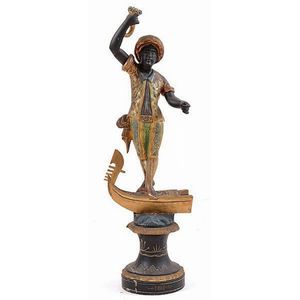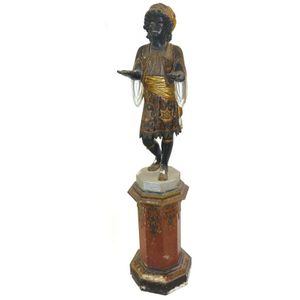19th Century Gilded Blackamoor Figure on Column Stand
You must be a subscriber, and be logged in to view price and dealer details.
Subscribe Now to view actual auction price for this item
When you subscribe, you have the option of setting the currency in which to display prices to $Au, $US, $NZ or Stg.
- Gilding - Gilding is a method of ornamentation whereby a thin sheet of gold metal is applied to items made of wood, leather, ceramics, glass and silver for decorative purposes.
For furniture including mirrors, the sheet of gold is usually applied over a coating of gesso. Gesso is a mixture of plaster of Paris and gypsum mixed with water and then applied to the carved wooden frames of mirrors and picture frames as a base for applying the gold leaf. After numerous coats of gesso have been applied, allowed to dry and then sanded a coat of "bole", a usually red coloured mixture of clay and glue is brushed on and allowed to dry, after which the gold leaf is applied. Over time parts of the gilding will rub off so the base colour can be seen. In water gilding, this was generally a blue colour, while in oil gilding, the under layer was often yellow. In Victorian times, gilders frequently used red as a pigment beneath the gold leaf.
Metal was often gilded by a process known as fire gilding. Gold mixed with mercury was applied and heated, causing the mercury to evaporate, the long-term effect of which was to kill or disable the craftsman or woman from mercury poisoning. The pursuit of beauty has claimed many victims, not the least of which were the artists who made those pieces so highly sought after today. - Gesso - A mixture of plaster of Paris and gypsum mixed with water and then applied to the carved wooden frames of mirrors and picture frames as a base for applying gold leaf. After numerous coats of gesso have been applied, allowed to dry and then sanded a coat of "bole", a usually red coloured mixture of clay and glue is brushed on and allowed to dry, after which the gold leaf is applied. In painting, gesso is also used to prime a canvas prior to applying paint.
This item has been included into following indexes:
Visually similar items

An impressive nephrite and gilt bronze censer inset with coral cabochons possibly Sino-Tibetan, 19th / 20th century, the spinach jade intricately carved with a dragon finial to cover and chilong to lugs which each support a ring handle, the body mounted wi

A Venetian polychrome blackamoor figure, modelled as a male standing on the prow of a gondoler, 105 cm high

A superb George IV silver gilt lidded yachting cup by Benjamin Smith, dated 1827, London engraved 'From Her Royal Highness the Duchess of Kent For Beaumaris Regatta 1832'. Inscribed on reverse, 'Won By the Zephyr Yacht Belonging to James Watson Esq. of Liv

A Victorian sterling silver octagonal Gothic tea caddy by Joseph Snr. and Joseph Jnr. Angell, mark over struck and engraved J Mayer, London 1845, 19 cm high, 575 grams
